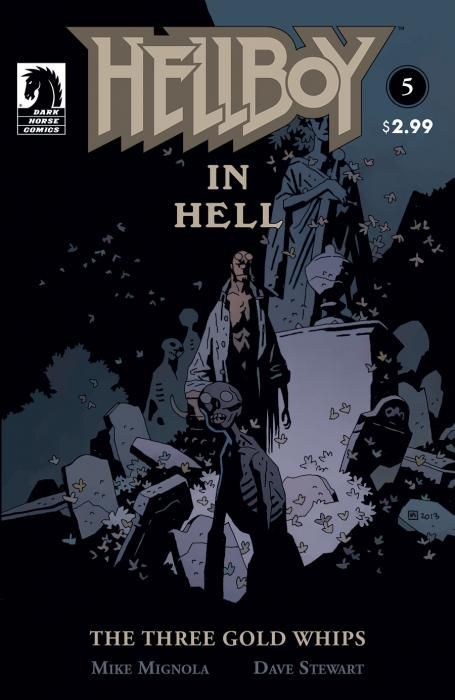The first four issues of "Hellboy in Hell" were excellent, as Mike Mignola returned to drawing his signature creation once more. With the new status quo for Hellboy (hint: he's in Hell), though, the one thing I was afraid we would have lost were all of the little one-off stories that Mignola has sprinkled throughout the character's life. With "Hellboy in Hell" #5, though, Mignola shows that while Hellboy might now be in the afterlife, that doesn't mean the loss of one of my favorite parts of the comic.
In many ways, "Hellboy in Hell" #5's story of "The Three Gold Whips" will ring familiar to longtime "Hellboy" readers. Hellboy meets someone who's in dire need of help on a supernatural level, and gets pulled into a bit of a hair-raising adventure with a good mix of humor and action. In the case of "The Three Gold Whips," though, it feels like something with a touch more emotion than normal. Perhaps it's because this time the person in need is someone who's in Hell, desperately trying to save their soul that they gave away for a less than ideal prize. This isn't just someone with a monster in their tower, or wolves in the basement. And with Hellboy sitting in the mostly-vacant avenues and alleyways of Pandemonium, it's not like we don't know what the fate of this foolish man will be if Hellboy loses.
At the same time, there's a lovely sense of humor that weaves its way through the book. Hellboy's hiding place in the grandmother's house is funny and surprising, for instance, and his reaction to the trading of the souls for the whips is so perfect that you can almost hear the incredulous tone to his comment, "Really? You guys said yes to THAT?" What's nice is that "Hellboy in Hell" #5 doesn't lose track of the larger plot. Mignola checks in on the state of Hell and its overlords, and in many ways this is the first real look into how the crumbling of Hell's normal order is going to play out within the realm of the damned. You can read this on its own and enjoy it, but as part of the larger series cosmology it clicks in perfectly with the surrounding pieces.
Unsurprising is how great Mignola's art is. Statues with tears running down their stone faces; a hill of tangled dead trees, staircases, and corpses; a jumble of graveyard headstones pointing every which way as they're all mashed together. Every scene is more eloquently drawn than the one before. I love how Mignola can draw what would look like a mess from almost any other artist and make it feel haunting and gorgeous here; it certainly doesn't hurt, of course, that Dave Stewart's colors continue to accentuate Mignola's art with a deliberately limited palette that doesn't draw attention away from the lines. There's also a strong usage of negative space, here. The grandmother sitting in pitch black on half the page is extremely striking; not only does it draw your eye right to her (so that you have to look at her details), but the darkness surrounding her gives her an extra ominous and foreboding look about her.
"Hellboy in Hell" #5 is a wonderful comic part of the series' greater whole, but at the same time feels self-contained. We've got Hellboy as hero, even as there's a bit of strangeness, humor and even playing around with timelines and echoes from the past. Reading "Hellboy in Hell" #5 reminds me of when I first came across "Hellboy: The Wolves of St. August," one of the earliest Hellboy stories and still one of my all-time favorites. This is absolutely enchanting, a real memorable way for the series to return.

